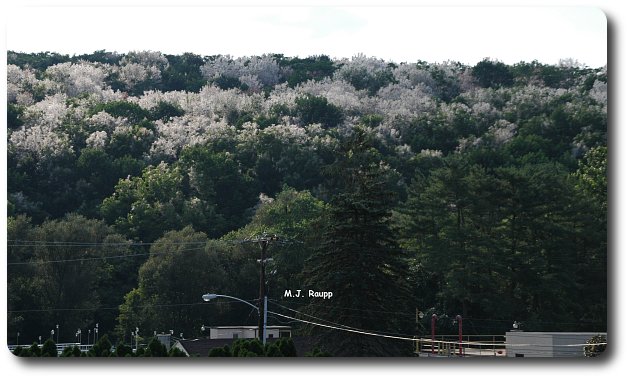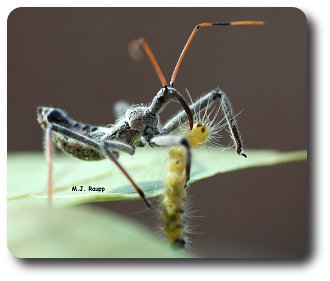One issue that really makes us peevish is the ever-increasing influx of exotic pests we find in our landscapes and gardens. Just think about the misery caused by Japanese beetles, gypsy moths, emerald ash borer, and the despicable brown marmorated stink bug. I am often asked if this is a one-way street with the USA the recipient of nasty bugs and the rest of the world getting off scot-free. Absolutely not! One of our pesky “gifts” to the rest of the world is the fall webworm. In the 1940’s this insect was accidentally introduced into Hungary from North America. It has spread throughout large parts of Europe and Asia. In China fall webworm is known as the North American White Moth and it has become one of the most devastating of all forest pests damaging thousands of acres of trees each year.
Webworm life
This poor honeylocust was completely covered with caterpillar silk and defoliated by mimosa webworm.
Although fall webworm is often confused with the eastern tent caterpillar we met in “The silk trail - Eastern tent caterpillar” April 4, 2011, they are easy to tell apart. Eastern tent caterpillars appear in March and early April in our area and build tents around twigs and in the crotches of branches near the trunk. The common hosts of eastern tent caterpillars are trees in the rose family such as cherry, crabapple, and apple. Fall webworms appear in May and June and build nests on the terminals of branches. Fall webworms are one of the most catholic of all caterpillars and eat several common trees in our area including cherry, crabapple, maple, sycamore, pecan, and walnut. Fall webworms are known to feed on more than 100 species of plants. As summer wanes, we near the finale of webworm activity for the year. Webworm caterpillars in the nests will soon vacate trees to form pupae in the leaf litter and duff beneath the tree where they spend the autumn, winter, and early spring. Next spring and early summer, adult fall webworm moths will emerge from the soil, find mates, and lay hundreds of eggs on the undersides of leaves of susceptible hosts. Tiny caterpillars hatch and spin small webs first around their natal leaf and later around small clusters of leaves on the same branch. Inside the relative safety of these webs, larvae munch leaves. As they grow, larvae enlarge the web to include ever-greater expanses of leaves and branches. When fall webworms are abundant, entire trees may be enclosed in these webs. After the first generation of webworms has developed, they move to the ground to pupate, new adults emerge, and the cycle repeats. In Maryland, two generations of fall webworm are common each year while in southern states such as Georgia and Texas as many as four generations can occur annually. In most years and most locations fall webworms do not cause serious damage to trees. However, their nests create a bad case of the uglies on trees that persists well into the winter. A second webworm of summer and fall is mimosa webworm. This rascal was imported from China in the 1940’s. Its favorite foods in the United States are mimosa and honeylocust. Like fall webworm, mimosa webworm completes two generations each year in Maryland with an additional generation in Georgia, Florida, and Alabama. It too spends the winter as a pupa in protected locations on or near its host. Adults emerge in late spring or early and fly to leaves where eggs are laid. Many thornless varieties of honeylocust are susceptible to the webworm, but the cultivars Moraine, Shademaster, and Imperial appear to be somewhat resistant.
Managing webworms
An assassin bug nymph deals death to a fall webworm caterpillar.
On small trees one easy way to be done with these messy guys is to simply remove them by hand or with pruners when you first see the nests. If nests are far above the ground, a pole pruner may be necessary. Professional arborists can help with serious problems on large trees by applying the formulated biological control agent Bacillus thuringiensis or reduced risk insecticides containing spinosad or tebufenozide. Fortunately for us, webworm cycles often wax and wane in a given area with years of great numbers followed by years of few. This is likely due to the fact that webworms are attacked by a great number of predators and parasitoids.
References:
Web sites listed below and the wonderful text, “Insects That Feed on Trees and Shrubs” by Johnson and Lyon and “Managing Insects and Mites on Woody Plants: An IPM Approach” by Davidson and Raupp were used as references for this episode. To learn more about fall and mimosa webworms, please visit the following sites.
http://ohioline.osu.edu/hyg-fact/2000/2026.html
http://woodypests.cas.psu.edu/FactSheets/InsectFactSheets/html/Mimosa_Webworm.html
http://www.ext.vt.edu/departments/entomology/factsheets/fallweb.html


